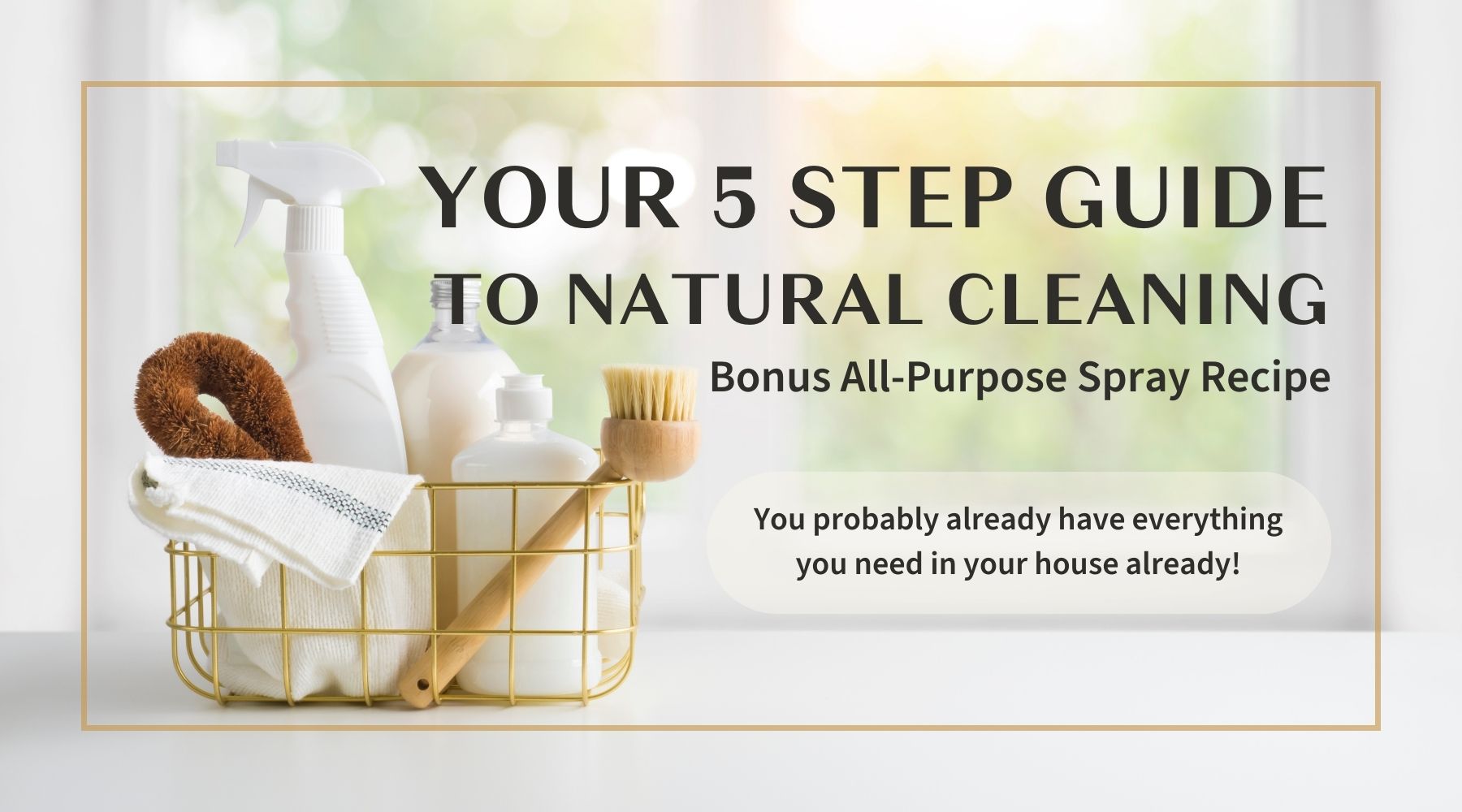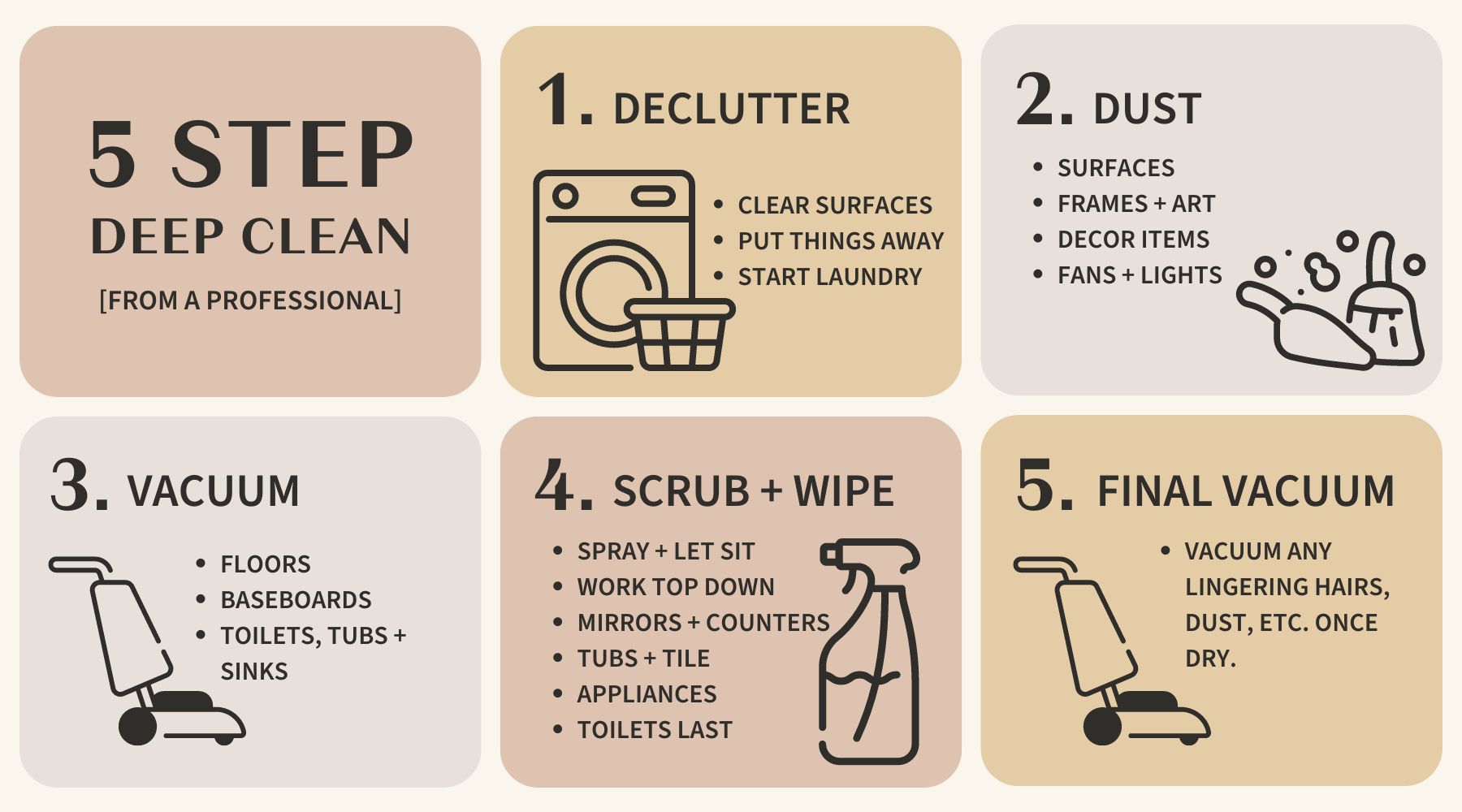
You absolutely do not have to break out all the harsh products to give your home a good old fashioned deep cleaning. Here are some quick tips and a recipe to get you started!
Col was a professional house cleaner for many years. This guide is based on how she does things, down to the most efficient order in which to do everything!

1. START WITH A GRAND DE-CLUTTER
Take an empty laundry bin with you to each room, and use it to contain anything that doesn't belong in that room. Put away everything that’s not in its place. Do all the dishes. Put in a load of laundry (including your linens). Start (or continue) a bag of stuff to donate. Get all the surfaces cleared off and ready for deep cleaning.
PRO TIP: While you’re doing the first step, make sure you don’t run water in the bathtub/shower or bathroom sink (if you have them) so they have time to dry. It’s much easier (and better for your equipment) to vacuum up hairs and dust in a super dry bathroom.
2. THEN THE DUSTING
You do not need a fancy thing to do this. All you need is a lightly dampened cloth (cotton, hemp, bamboo, etc. are our favorites, but use what you have!). Head around each room (or your only room, if you live real tiny), and give everything a good dusting. Wipe down picture frames, shelves, the stuff on the shelves, door frames, window sills, etc.
EXTRA: You can get intense about this, and make your own reusable “swiffer” duster if you want to, but it’s not required. If you make your own, you can use natural fabric. Microfibre and fleece are not biodegradable. They contribute to both landfill waste and micro-plastic waste, which enter our water sources when you wash them. If you have synthetic fibers around the house you need to wash, you can use a special bag to keep microplastics out of our water systems, but they are expensive!
3. VACUUM
This one’s going to show up twice, but don’t run away from your computer just yet. After many years of cleaning professionally, trust us. This is the fastest, best, and most thorough way to get stuff super duper clean. Vacuum your carpet, linoleum, and/or hardwoods. Be sure to get the baseboards! You can even vacuum off your (dry) kitchen counters and stove if you want/need to. Now take that vacuum into the bathroom (which should be nice and dry at this point), and use the hose attachment to vacuum up any dust and hairs from the toilet, shower/tub, sink, etc.
4. CLEAN YOUR SURFACES
Using your homemade all-purpose spray (recipe below), spray down your bathroom surfaces, and then your kitchen surfaces. For the best antibacterial benefits and ease of scrubbing, let your solution sit for at least 10 minutes.
Use a cloth to wipe down your bathroom mirror and sink, followed by the tub/shower, and do the toilet last. If the sink and/or tub need extra scrubbing, use a *natural brush or whatever you already have. If even more scrubbing power is needed, try using some baking soda. Don’t forget to rinse! A removable, long-neck shower head is especially handy for this. If you don’t have one, grab a pitcher or large container to fill and rinse with. Baking soda can also be used inside the toilet bowl, with a natural toilet brush. Additionally, we recommend using a pumice stone to get rid of any unsightly toilet bowl rings.
Grab a clean rag, and wipe down all your kitchen surfaces. If you need to clean the inside of your microwave, microwave a cup of water in there for a couple minutes and let it steam. It will soften all the crud, and then you can spray it with your all-purpose spray, and wipe it clean. Baking soda works great for kitchen sinks, and it’s safe for both porcelain and stainless steel.
For linoleum and hardwoods, you can use a washable mop if you want to. We don’t have enough linoleum to warrant storing a mop. We literally just get a cloth wet with our all-purpose cleaner, throw it on the floor, and scrub it around with our feet. Cheap, fast, and easy! Don’t worry about the inevitable remaining dust or hairs that get kicked up as you’re doing these surface cleans. We’ll get to that.
EXTRA: Your spray is a natural disinfectant. Dampen a cloth with it, and use that to clean all the touch-points in your home, like doorknobs and light switches in particular.
When you’re done with this step, chill out for a few minutes. You deserve it.
5. THE FINAL VACUUMING
This is the last step. It doesn’t matter how thoroughly you vacuum the first time. When you’re moving stuff around, and cleaning surfaces, more dust and hairs are always going to show up. The easiest thing to do is just to wait for your floors to dry, and then give them all another quick vacuum before you put it away.
That’s all the cleaning! You can grab your fresh linens out of the dryer, and make the bed. Put clean towels up in the kitchen and bathroom. If you really went all out, you can re-hang your shower curtain and/or window curtains.
MATERIALS**
Vacuum
Distilled White Vinegar
Baking Soda
Natural Toilet Brush
Pumice Scouring Stick
Natural Scrub Brush
Spray Bottle(s)
Natural Cleaning Cloths
*We are physically disabled, and frequently use mobility aids to assist us. For example, Bee uses a telescopic electric scrub brush to clean the tub. One of the many reasons being 100% Zero Waste is just not practical for a huge number of people.
**None of these are affiliate links, and no links go to Amazon, but we don't judge. Sometimes it's the only option. When we share sources, we do try to link only to fellow small businesses. Remember, using what you already have on hand is what true sustainability looks like!

Natural All-Purpose Spray Recipe:
CLICK HERE to download PDF recipe card.

In a spray bottle, combine:
- 1/4 Cup White Vinegar
- 2 Cups Distilled (or filtered or boiled) Water
- 1 Teaspoon Castile Soap*
- 10-30 Drops Essential Oil*
- 1-2 Tablespoons Rubbing Alcohol*
*Optional but recommended.
Suggested Essential Oils:
Tea Tree, Rosemary, Lemon, Lime, Thyme, Clove, Lemon, Cedarwood, Peppermint, Eucalyptus, Lemongrass, Lavender, Cinnamon, and Bergamot.
All of these essential oils can add anti-bacterial, anti-viral and anti-fungal power.
-------------------------------------------

SOME FINAL NOTES
Remember, NEVER mix vinegar and bleach! Both *can* be used for tough jobs like mold infestations, but they must be kept separate, and allowed to dry completely before coming in with the next solution. You should also never mix vinegar and Hydrogen Peroxide together as it's highly corrosive.
Baking Soda and Vinegar neutralize each other if they're used at the same time. The chemical reaction that happens (foaming and bubbling) is still helpful for loosening and lifting grime in places like garbage disposals and sink drains.
It's best not to use Rubbing alcohol or Hydrogen Peroxide on painted surfaces because they can lift color and/or dull sheen.


Comments (0)
Retour vers Simple Alchemy Co Blog